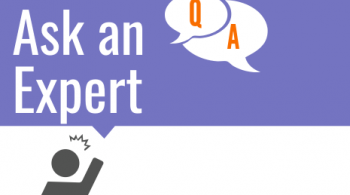April 5, 2016
As part of our focus on Autism Awareness Month throughout April, Lisa Carey, M.A. (LC) interviewed Dr. Jonathan Schmidt (JS) to help answer some questions about applied behavior analysis (ABA) as an evidence-based practice for teaching students with autism spectrum disorder (ASD).
Dr. Jonathan Schmidt (JS) is the faculty director of the Principles of Behavior Change core at the Center for Innovation and Leadership in Special Education (CILSE), as well as a senior behavior analyst in the Neurobehavioral Unit Inpatient Program at the Kennedy Krieger Institute (NBU). At the NBU, he supervises the assessment and treatment of individuals who are admitted for severe problem behavior and consults with relevant caregivers to ensure effective service delivery. Dr. Schmidt is also an assistant professor in Psychiatry and Behavioral Sciences at the Johns Hopkins University School of Medicine.
LC: Applied behavior analysis is often listed as an evidence-based practice for teaching students with autism spectrum disorder. Can you explain what ABA is and why it’s been successful with students with ASD?
JS: ABA systematically uses behavioral methods to target socially significant behaviors for change and helps students learn by arranging the environment to promote success (Baer, Wolf, & Risley, 1968). After identifying socially important goals for an individual, the emphasis often moves to attempting to improve desired behaviors and/or decrease undesired behaviors.
It is critical that before attempting to decrease any undesired behaviors, you determine what behaviors you want to increase or see occur more frequently, because the ultimate goal should be to build skills. Instruction occurs by structuring the environment to understand the target behavior and engaging in repeated and consistent instruction to strengthen the contingencies for targeted behaviors/skills. Many educational professionals and parents alike prefer ABA strategies because they can offer predictability. ABA strategiesclearly delineate how to respond to students and how to help students understand the relationship between their behavior and consequences. From the outset of any instruction, ABA emphasizes planning for generalization so that the student can perform the behavior across environments, people, and time.
Overall, ABA has an extensive evidence-base of over 40 years supporting its use for teaching youth with an ASD. This means that a large number of peer-reviewed scientific studies that evaluated assessment and treatment strategies using ABA have been conducted and have been shown to have a positive impact on youth with an ASD.
Because students with an ASD will most likely have deficits in communication and social interactions and issues with restricted or repetitive behaviors, it can be difficult for them to navigate their environments effectively. This can restrict their opportunities for learning. ABA helps these students by explicitly teaching them the skills they need to function with more independence and to facilitate skill growth for development. This is accomplished by clearly defining targets or goals and the steps necessary to achieve them, developing operational definitions of behaviors, taking baseline data on the behaviors of interest, and then implementing interventions to see how behaviors are affected.
There is a variety of ABA strategies and treatment packages that have been shown to be effective for students with an ASD. Some of the basic behavioral principles that permeate these packages include:
- Differential reinforcement (reinforcing desired behaviors);
- Noncontingent reinforcement (providing free access to preferred items, activities, or attention);
- Extinction (not responding to a behavior with a functionally related consequence); and
- Punishment (implementing consequences to decrease the likelihood undesirable behavior will occur again in the future).
- What common misconceptions do educators have about ABA?
The most common misconceptions I have heard from educators about ABA often stem from misunderstandings about what exactly ABA represents. Once they learn more about ABA, their misconceptions are often rectified. One common myth is that ABA is only for students with autism and that all students with autism need 40 hours of ABA delivered in a 1:1 format in order to be successful. ABA procedures are valuable for everyone, children and adults, regardless of whether or not they have a diagnosis of an ASD. Some students will need long-term comprehensive treatments, whereas others may only need more short-term focused treatments.
For all students with an ASD, it is important to first detail exactly what the goals will be for that specific student, and then determine the types and duration of therapy that will be needed to accomplish those goals. Many students will not need extended 1:1 instruction and will respond favorably after minimal instruction to the contingencies that are set up in their environment; however, for other students where their deficits or behaviors are more severe, more intensive services will be warranted.
Many people think that ABA is synonymous with discrete-trial training. In actuality, discrete-trial training is one strategy within ABA that is often used to teach students new skills, but is not wording that should be used interchangeably with ABA. Discrete-trial training was heavily emphasized within the original instruction of the famous Lovaas comprehensive treatment program (Lovaas, 1987), and has been shown to be beneficial for a number of individuals with an ASD. However, ABA emphasizes the use of behavioral and learning principles to emphasize how the environment affects behavior, and thus is encompassed within other instructional programs as well.
Another misconception that educators have about ABA is that it turns students into robots. With ABA, programming for skills should emphasize having the relevant behaviors occurring across caregivers, settings, and other similar situations. Focusing on certain areas, such as social skills, can be difficult for some individuals with ASD, and thus sometimes will need to occur in an initially more contrived format to try and enhance acquisition and fluency with the relevant skills. However, the end goal is always to increase the student’s ability to function independently and generalize these skills.
LC: A lot of educators have concerns about addressing the behavioral needs of students with ASD. What are some things they should keep in mind when addressing disruptive behaviors?
JS: Students with an ASD are more likely to exhibit problem behavior than their undiagnosed peers. I think it is important to remember that the students are in school to learn and want to be successful.
Behaviors should be targeted for change just like academic skills are targeted for change. If a student is having trouble learning a new academic skill or being fluent with an academic skill, you would try to understand the reason for why the student is struggling, try teaching them the skill using new approaches to specifically target the reason for their difficulty or deficit, and potentially give them additional support until they are ready to operate with more independence. Just as you would tailor the academic interventions to the student, it is critical to do the same with disruptive behaviors.
The foundation for addressing disruptive behavior is to first try and understand why the behaviors are happening. When disruptive behavior occurs, the first step is to determine the “function” of a behavior, which means to figure out why the behavior is occurring or what the student is trying to communicate to you.
Behaviors are traditionally going to be classified as being maintained by attention, escape, tangible items (toys, activities, or food), or automatic or sensory reinforcement. After determining the function of the behavior, you are then able to focus on effective treatments to target a specific context where the disruptive behavior is likely to occur.
Common treatments involve antecedent (arranging the environment to reduce the likelihood of disruptive behavior occurring) or consequence-based (adjusting what happens after a behavior occurs) strategies. It is important to remember that sometimes you may be able to change the behavior of the student by teaching them new skills or setting up desirable contingencies, but another key approach involves changing the behavior of those who interact with the student, or changing the environment.
LC: Some educators have concerns that using ABA means you can’t use other instructional approaches to address social and academic learning for students with ASD. What is your take on that?
JS: One of the key mechanisms of ABA involves using the scientific method and making changes systematically. Primary components of this are to develop clear definitions of the target behaviors you want to measure, implement your interventions one at a time when possible, and make data-based decisions to determine what is effective and what isn’t working quite the way you had hoped. This approach allows you try out different instructional approaches as long as you are collecting data to evaluate the instructional method, and the potential benefits of using a specific type of intervention outweigh the costs. Ultimately, regardless of the approach you are using, you want to be sure it is evidence-based and has a high likelihood of achieving the goals for the student.
LC: Any closing words of advice for teachers working with students with ASD?
JS: Be patient and methodical, and realize that you can impact these students’ lives greatly. Also, be a healthy skeptic of any approach, even behavioral interventions that you are implementing. Be willing, however, to adapt your views and philosophy so that you can continue to grow and develop effective practices. Because you are on the front line, and leading the way for making changes in these students’ lives, it is critical to try and stay up to date with the latest peer-reviewed interventions, and when necessary, step outside of your comfort zone and be willing to change your approach.
Additionally, clear goals that everyone agrees on and a strong data collection system that guides decision-making, are key components for determining if assessment and treatment procedures are effective, because ultimately, your time and effort is invaluable.
References:
- Baer, D., Wolf, M., & Risley, T. (1968). Some current dimensions of applied behavior analysis. Journal of Applied Behavior Analysis, 1, 91-97.
- Lovaas, O. I. (1987). Behavioral treatment and normal educational and intellectual functioning in young autistic children. Journal of Consulting and Clinical Psychology, 55(1), 3-9. doi:10.1037/0022-006X.55.1.3















